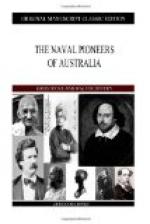Take the map of Tasmania and look at a group of islands at its north-east corner; they are in what was later on to be called Bass’ Straits. Among them are two named Preservation and Clarke Islands; these and Armstrong Channel commemorate the wreck of the Sydney Cove, which occurred on February 9th, 1797. The Sydney Cove was an East Indiaman bound from Bengal to Sydney; she sprang a leak, was with difficulty navigated to the spot named Preservation Island, and there beached.
[Illustration: CAPTAIN MATTHEW FLINDERS, R.N. From the “Naval Chronicle” for 1814.] [Sidenote: To face p. 170.]
The crew, many of whom were Lascars, were saved, with a few stores. Then the long-boat, with the mate, supercargo, three European seamen, and a dozen Lascars, was despatched in an endeavour to reach Port Jackson, the only occupied part of the great continent, and bring succour to their starving shipmates. They set out on the 28th February, were driven ashore; their boat was battered to pieces on the rocks, and they escaped only with their lives. This happened on the 1st of March, the scene of this second misfortune being a little distance to the north of Cape Howe, 300 miles from Sydney. These castaways were the first white men to land in what is now the colony of Victoria. (The spot where the boat was lost is just over the border.) After resting the men then all set out to march along the coast to Sydney.
Sixty days later three exhausted creatures reached Wattamolla harbour, near what is now the National Park of New South Wales, about 18 miles south of Sydney. The remainder of the castaways had dropped and died of exhaustion on the march, or had been speared by the blacks. Those who survived had purchased their lives from the savages with shreds of cloth and buttons from their ragged clothing, and had kept themselves alive with such shell-fish as they could find upon the beaches. At Wattamolla they had halted to cook a scanty meal of shell-fish, and the smoke of their fire revealed their presence to a fishing boat from the settlement at Port Jackson. The fire by which this cooking was done was made from coal found on the beach there; so reported brave Clarke, the supercargo of the Sydney Cove, who found it.
As soon as Hunter heard of the discovery he determined to examine the place. In a despatch home he says:—
“So I have lately sent a boat to that part of the coast, in which went Mr. Bass, surgeon of the Reliance. He was fortunate in discovering the place, and informed me he found a stratum six feet deep in the face of a steep cliff, which was traced for eight miles in length; but this was not the only coal they discovered, for it was seen in various places.”
The place was named Coalcliff, and this was the first discovery of the great southern coalfields of New South Wales. Hunter, writing to the Duke of Portland under date of March 1st, 1798, shall tell the next incident of Bass’ career:—




